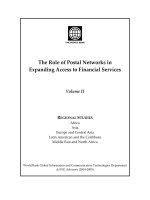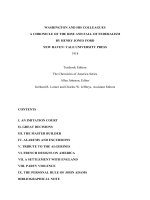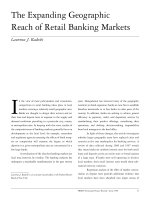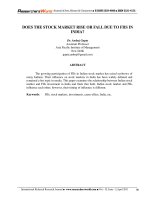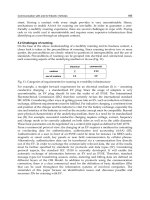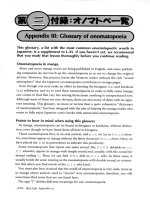The Rise and Fall of Abacus Banking in Japan and China phần 10 docx
Bạn đang xem bản rút gọn của tài liệu. Xem và tải ngay bản đầy đủ của tài liệu tại đây (435.65 KB, 30 trang )
Exhibit 7.6
Bank Net Loans in China (1980–1997) (percent of total assets)
Exhibit 7.7
Bank Net Loans in the United States (1980–1995) (percent of total assets)
156 The Rise and Fall of Abacus Banking in Japan and China
and terms they offer for lending and have provided a range of services not
offered by banks. They also had access to funding other than conventional de-
posits and have provided stimulating competition to traditional financial insti-
tutions.
19
ITICS amassed huge amounts of funds both in the domestic and in foreign mar-
kets for the purpose of financing provincial and local projects such as housing
and commercial real estate projects. ITICs played an important role. They pro-
vided funds to China’s less reputable companies that wouldn’t have access to
domestic equity markets and foreign banks.
20
Owned and controlled by provincial and local governments, which are
often at odds with Beijing over the direction of economic policy, ITICs
escaped from regulation and central government control, turning into
some kind of discretionary, hidden reserves of local governments.
‘‘These TICs were born as a kind of hidden reserve for provincial gov-
ernments. They were forced by local governments to make investments
in local projects or give loans to local enterprises. They lacked self-
discipline and monitoring by the central bank.’’
21
In this sense,
Their role in China’s financial system has been characterized by a series of cy-
clical swings, with expansion and diversification being encouraged during cycli-
cal upturns, only to have their numbers, growth and scope of activity tightened
during more strained economic periods.
22
SITICO, TITIC, and ZITIC are three cases in point. SITICO, for in-
stance, is 85 percent owned by the Shanghai municipality and functions
as a development bank in the Shanghai region, engaged in the financing
of the local automotive company, hotels, real estate, and land develop-
ment. TITIC is owned by the Tianjin municipal government and also
functions as a local development bank, financing technology companies
and real estate projects, and even trading unlisted stocks. ZITIC is owned
by the Zhejiang provincial government and is engaged in the leasing,
real estate, and hotel business.
Escaping the close scrutiny of government regulators, as has been the
case in other Asian countries, most notably with their counterparts jusen
in Japan, ITICs have turned into speculative vehicles, financing bubble-
prone sectors such as the construction sector (see Exhibit 7.8). In fact, the
signs of over-construction are evident across China’s major cities, where
many buildings are unfinished and abandoned, especially in Shanghai,
where over 50 percent of buildings are vacant.
23
According to Lardy,
Exhibit 7.8
Production, Employment, and Establishments in the Construction Sector in China (1981–1996)
158 The Rise and Fall of Abacus Banking in Japan and China
By the mid-1990’s, far too much had been built. Beijing, Shanghai, and Shenzhen
appear to have the highest concentrations of unleased luxury villas and town-
houses and first-class office space, but many smaller cities, ranging from Haiku
on Hainan island to Beihai in Guangxi, have a significant problem of over-
building.
24
China’s excess capacity is also reflected in excessive duplication of ec-
onomic activity (i.e., the establishment of companies producing similar
products, just for the sake of creating employment for the excess labor).
‘‘Companies built too many office buildings, started too many factories
and borrowed money during the boom years.’’
25
In fact, in 1997, the
Chinese government openly admitted that about half of its industrial
product factories ran at 60 percent capacity.
In short, as was the case in Japan, China’s banking crisis is the result
of the rise and fall of abacus banking strategy. An editorial in Euroweek
stated that
Daunting difficulties of restructuring the country’s loss-making state owned en-
terprises and increasing unemployment are straining the financial resources of
China’s central and local governments and this weakens their ability to support
the ITICs that they control.
26
Hainan Development Bank is a good example of the rise and fall of
abacus banking in China. The bank rose along with the economic growth
of the Hainan province and also fell along with it. GITIC is another case
in point. When the economy grew, the province was in a position to
borrow heavily, both in domestic and international markets. ‘‘Guang-
dong became a state within a state, a political fiefdom run by local lead-
ers who paid lip service to Beijing.’’
27
Without proper feasibility studies
to evaluate the alternatives of economic resources, the province poured
billions of dollars into small-town airports, dams, and commercial real
estate that were never utilized, especially as the economy slowed down.
Consider Zhuhai’s international airport. Costing $400 million to build, it
handles less than a half dozen domestic flights a week, and therefore is
grossly underutilized.
28
China’s efforts to preserve growth in coastal provinces that formerly
relied heavily on exports for their prosperity are reflected in the unequal
growth of state bank loans. State bank loan growth to coastal areas, for
instance, increased from close to 20 percent in 1990 to around 44 percent
The Looming Banking Crisis in China 159
in 1994, while loan growth in other areas of the country dropped from
around 24 percent in 1990 to around Ϫ1 percent (see Exhibit 7.9).
At this point, one may raise two important questions. How did Chi-
nese banks survive on a negative interest rate spread? Why have mon-
etary expansion and excess liquidity not created hyperinflation? There
are two reasons, according to Fry.
29
First, because of the issuance of bank
bonds, which in essence have reduced banks’ net worth. Indeed, bond
issues increased, from about $15 billion in 1993 to $38 billion in 1999.
30
Second, because of the preservation of one of the conditions of abacus
banking—the regulation of financial markets and interest rates—which
maintained a wide margin between demand deposits and time deposits,
allowing banks to continue to derive seigniorage income. According to
Kime,
The Chinese government continues to regulate closely all deposit and lending
rates and to limit the financial instruments available to the public. In addition,
by insuring that China’s state-owned banks maintain a near monopoly over the
economy’s financial resources, the government has forced the public to hold its
financial wealth in the form of either non-interest earning currency or in state-
bank deposits that sometimes earn negative real rates of return.
31
In fact, interest rate controls and financial regulation are the ‘‘Achilles’
heel’’ of the Chinese banking system. One must therefore understand
China’s reluctance to deregulate her financial markets, especially interest
rates. Should such deregulation take place and the gap between short-
term rates and long-term rates narrow, Chinese banks would no longer
survive on seigniorage income, declaring insolvency, which was the case
with some of their Japanese and Southeast counterparts in the 1970s and
the 1980s.
Once again, China faces a dilemma—preserve her financial regulation,
risking her integration into the global economy, or proceed with dereg-
ulation and risk a full-scale banking crisis that would dwarf that of Japan
and other Asian countries.
To sum up, as was the case in Japan and other Asian countries, China’s
looming banking crisis reflects excess liquidity and excess capacity, fu-
eled by an overexpansion that created both a commodity and an asset
bubble. But unlike the other Asian countries and Japan, China’s bubble
is government-driven. It reflects the desperate attempts of Beijing and
provincial governments to hold onto the old system of central planning
that allocates resources according to the principles of central planning
Exhibit 7.9
Annual Growth Rate of Loans in State-Owned Banks by Region (1990–1994)
Source: Adapted from China Finance Society (various years).
The Looming Banking Crisis in China 161
rather than according to the principles of efficiency and risk manage-
ment. China’s banking crisis further reflects the clash between the two
opposing forces—the concentric forces that pull it toward centralization
and the planning and centrifugal forces that pull it toward market
forces—a conflict between those who support inefficient SOEs and those
who support private-owned enterprises:
There is still an inherent conflict in China between a country committed to prop-
ping up its inefficient and loss-making enterprises with free government hand-
outs and via the banks and one which is supposed to be committed to the
advancement of market forces.
32
NOTES
1. WuDunn (1998).
2. Wei and Zeckhauser (1998).
3. Smith and Leggett (1999), p. A18.
4. ‘‘China: Asia’s Next Casualty,’’ Business Week (editorial), December 15,
1997. See also The Economist Intelligence Unit, ‘‘Financing Foreign Operations
in China’’ (June 1997), p. 28, and I. Johnson, ‘‘China Plans to Close Trust Com-
panies in Crackdown,’’ Wall Street Journal, January 7, 1998.
5. Gilley, ‘‘Breaking the Bank,’’ Far Eastern Review, July 16, 1998, pp. 66–68.
6. Ibid., p. 68.
7. Fry (1998), p. 93.
8. In fact, as was the case in Japan, non-performing loans are often buried in
SOE subsidiaries set up for this purpose or not even recorded at all.
9. Smith and Leggett (1999), p. A17.
10. Brean (1998), p. 8.
11. Zhang (1998), p. 1.
12. Lu and Yu (1998), p. 161.
13. I. Johnson, ‘‘China Calls for More Spending to Avoid Recession,’’ Wall
Street Journal, March 4, 1999, p. A9.
14. In the mid-1980s, China introduced both a corporate tax and a VAT tax,
but given the ownership structure of the SOEs, it has not produced the expected
results. For a detail discussion see Hay et al. (1994).
15. In fact, as it is often argued in the economic literature, a trade-off exists
between seigniorage income created by issuing currency and the ability of gov-
ernments to raise taxes (see Fry 1998).
16. C. Lo, ‘‘China Utilizes Its Banks, Choosing Growth over Reform,’’ The
Asian Wall Street Journal Weekly, Vol. 20, No. 30, July 27, 1998, p. 16.
17. Brean (1998), p. 8.
18. H. Sender, ‘‘Floods of Money,’’ Far Eastern Review, October 1, 1998, p. 58.
162 The Rise and Fall of Abacus Banking in Japan and China
19. Kumar et al. (1998), p. 1.
20. B. G. Knecht, ‘‘China’s Big Trusts Teeter on Extinction’s Edge,’’ Wall Street
Journal, November 6, 1998, p. A10.
21. H. Saywell, ‘‘Tic Fever,’’ Far Eastern Economic Review, October 28, 1998,
p. 54.
22. Kumar et al. (1998), p. 3.
23. A. Tanzer, ‘‘The Shanghai Bubble,’’ Forbes, April 20, 1998, p. 48.
24. Nicholas Lardy, ‘‘China and the Asian Contagion,’’ Foreign Affairs, Vol. 77,
No. 4 (July–August 1998), pp. 78–88.
25. C. S. Smith, ‘‘Once Wealthy Guangdong Is Now Riddled with Debt,’’ Wall
Street Journal, February 23, 1999, p. A17.
26. ‘‘China’s ITICs Feel the Heat from Moody’s,’’ Euroweek (editorial), January
30, 1998, p. 14.
27. Smith, ‘‘Once Wealthy Guangdong Is Now Riddled with Debt,’’ p. A17.
28. Ibid., p. A17.
29. Fry (1998).
30. Johnson, ‘‘China Calls for More Spending to Avoid Recession,’’ p. A9.
31. Kime (1998), p. 14.
32. ‘‘China’s Economy: Red Alert,’’ The Economist (editorial), October 24, 1998,
pp. 23–26.
Chapter 8
Conclusions
The revolutionary idea that defines the boundary between modern
times and the past is the mastery of risk; the notion that the future
is more than a whim of the gods and that men and women are not
passive before nature.
—Peter Bernstein
1
Revolutionary ideas are not always popular, especially for those who
find complacency and comfort with the status quo, those who believe
that the future will be just a replica of the past and the present.
For several decades, the mastery of risk was an unpopular, irrelevant
idea among Japanese and Chinese bankers, who found comfort and com-
placency in a fast-growing economy and government regulation (Japan)
or government ownership (China), an environment that turned banking
into a routine accounting system, an abacus operation procedure. Every
year was another growth year under cozy government protection, bring-
ing more of the same business, more deposits, more corporate loans, and
more profits. Like bread dough in the oven, banks could earn seigniorage
income simply by waiting, by riding along an uphill, safe ride rather
than by venturing into new business territory.
In the 1990s, the mastery of risk became popular or at least relevant
among Japanese and Chinese bankers, who could no longer find comfort
164 The Rise and Fall of Abacus Banking in Japan and China
and complacency in a slow-growing and less-regulated environment.
Every year was no longer a growth year under government protection,
and every year did not bring more of the same business, but different,
less predictable business and non-performing assets. Like it or not, Jap-
anese and Chinese bankers have come up against the ‘‘boundary’’ that
separates the old from the new times, the passive acceptance of destiny
from the mastery of risk, a boundary that they have yet to cross.
An inquiry into the Japanese and Chinese banking crises, this book
searches for answers to such crises beyond non-performing assets to the
economic environment, ‘‘the regime,’’ as Mancur Olson would have put
it, which sets the parameters of the game and nurtures management
behavior. In particular, this book argues that an American-style rescue
package is not sufficient to end the Japanese banking crisis or to avert
the looming Chinese crisis because these crises are rooted in the very
nature of the Japanese and Chinese economies that deprive bank man-
agers of the freedom, the ability, and the incentives to master traditional
and non-traditional banking risks. Accustomed to high growth and tight
government regulation, or outright ownership that limited competition
(Japan) or rationed credit (China), and in effect controlled management
behavior, Japanese and Chinese bankers have grown up as abacus bank-
ers, masters of the abacus or the computer just for the monitoring of
money flows rather than for managing risks.
As masters of the abacus, Japanese and Chinese bankers relied on
passive-volume lending and seigniorage income for their survival and
prosperity. This was particularly true during the high-growth eras (1950–
1989 for Japan and 1978–1993 for China), when robust economic growth
boosted personal income and savings and provided a steady flow of
deposits to the banking system, while government regulation limited
traditional and non-traditional banking risks. Bank deposits were in turn
channeled to the large corporate sectors of the two countries, creating
seigniorage income and providing steady welfare to their labor force at
the same time.
Relying on volume lending and functioning as welfare agencies rather
than as true banks, Japanese managers by nature and Chinese managers
by social rule were possessed by a mass hysteria, rushing to load and
then unload assets indiscriminately, causing wild price gyrations and
financial crises. As the economy expanded, against every principle of risk
management, Japanese and Chinese bankers financed investments in
overvalued real estate, equities, art, and other objects of speculation. As
the economy contracted, Chinese and Japanese bankers in particular
Conclusions 165
faced piles of non-performing assets and a genuine task to reckon with—
learning to behave as true bankers, that is, to manage traditional and
non-traditional risks, a problem that takes much longer to solve than
unloading non-performing assets.
Arguing these points in more detail, this discussion advanced in two
parts. Upon reviewing Japan’s postwar model of export-led industriali-
zation and economic experience, Part I of this book identified and elab-
orated on the conditions that contributed to the rise and fall of abacus
banking and the banking crisis that followed. Upon reviewing China’s
postwar economic experience, especially the 1978 economic reforms, Part
II of this book addressed the rise and fall of abacus banking in China
and the looming banking crisis in the offing.
Focusing on the ‘‘extended high-growth’’ era (1950–1989), Chapter 2
argued that robust, export-led economic growth and tight government
regulation built a sense of complacency among Japanese bankers, a feel-
ing of a secure, prosperous world to be conquered without any special
effort, a subtle risk management strategy. Steady economic growth al-
lowed banks to progress in tandem and to compete on high-volume, low-
profit-margin lending, taking a steady share of an ever-larger pie.
Exchange rate controls limited foreign currency risks. Government pro-
tection from foreign competition and the bailing out of individual cor-
porations limited systemic or aggregate risk. BOJ overlending in essence
eliminated liquidity risk. Long-term and keiretsu relations between banks
and their clients and rising asset values virtually eliminated individual
risks. An ‘‘escorted convoy’’-style MOF banking regulation system that
protected banks from foreign and domestic competition further limited
systemic credit risk.
A steady cash flow and a low-risk lending environment reduced Jap-
anese banking to an accounting system, a gatekeeper of the river flow
of funds from bank lenders (depositors) to bank borrowers (large cor-
porations). Along the river flow, banks’ profits could climb steadily and
risk-free, just by appropriating the difference between loan interest and
deposit interest. Besides, as members of keiretsu groups and functioning
within the Gosou-sendan Houshiki (the ‘‘escorted convoy’’ system), bank
managers had little freedom to manage their portfolios according to the
principles of profit maximization and credit risk management.
Japan’s rapid postwar, export-led industrialization and cozy govern-
ment and keiretsu relations were not destined to last forever. Under ex-
ternal and internal pressures, the Japanese economy began to open its
markets to domestic and foreign competition, turning the banking en-
166 The Rise and Fall of Abacus Banking in Japan and China
vironment from a certain to an uncertain world. Elaborating on this ma-
jor shift in the Japanese banking environment, Chapter 3 argued that a
negative interest rate spread, a shift of corporate financing from bank
loans to equity, the erosion of keiretsu relations, the slowing of economic
growth and savings, and asset deflation turned banking from a routine,
passive operation to an active risk management operation that could no
longer be handled by the abacus or even the ATM machines that began
to replace it.
Specifically, after the 1985 Plaza Accord, banks faced an uncertain,
risky world:
• The lifting of exchange rate controls increased currency risks.
• The lifting of trade protectionism raised systemic credit risks.
• The abandonment of the policy of overlending by the BOJ raised liquidity risks.
• The disbanding of the ‘‘escorted convoy’’-style banking regulation system no
longer protected banks from internal and external competition, further raising
systemic credit risks.
• The erosion of keiretsu relations and the decline in asset values, especially land
values, raised individual risks.
• The slowdown in economic growth undermined the thin interest rate profit
margin–large-volume lending strategy and bogai, the ‘‘detour’’ or cover-up of
short-term losses.
Though gradual, the shift from a low-risk environment to a high-risk
environment brought banks in a speculative frenzy that took them to the
summit and then all the way to the bottom of the world banking system.
Specifically, the yen appreciation, financial liberalization, and the mon-
etary easing that followed the Plaza Accord had a contradictory impact
on Japanese banks. On the one hand, expansionary monetary policy in-
creased liquidity and fueled economic growth and asset inflation, ex-
panding bank opportunities at reduced risks. On the other hand,
financial deregulation intensified competition between banks and money
market mutual funds and raised deposit interest rates, driving the inter-
est rate spread negative, especially during the bubble years. In addition,
rising corporate profits and a stronger yen allowed large corporations to
raise funds internally or in the Eurobond and equity markets. Many of
the country’s largest corporations would issue equity or debt not for the
purpose of financing their investment needs but in order to add excess
capacity or deposit it in banks, taking advantage of the high interest
rates.
Conclusions 167
The yen appreciation, financial deregulation, and hyperliquidity pro-
vided the funds, and deregulation provided the opportunity and the
incentive for engaging banks in speculative activities. Caught in excess
liquidity, a negative interest rate spread, and a declining demand for
low-risk corporate loans, banks began to search for new clients in the
high-risk small- and medium-sized corporations, real estate, and any
other investment opportunity opened up by deregulation. Hyperliquid-
ity and government deregulation prompted a restructuring of banks’ bal-
ance sheets, increasing their exposure to traditional and non-traditional
banking risks.
Elaborating on this shift in banking strategy, Chapter 4 argued that
the Japanese banking crisis is the result of the rise and fall of the strategy
of abacus banking. Nurtured in an environment of fast economic growth,
keiretsu relations, and tight government regulation, Japanese bankers lack
the ability, the incentives, and the skills to manage funds in a risky en-
vironment. Finding themselves with excess liquidity, Japanese banks ei-
ther directly or indirectly (through the jusen) extended credit to Gene-con
and other investors based on inflated bubble values rather than on eco-
nomic fundamentals. So when the bubble burst and asset prices declined,
banks ended up with non-performing assets. In this sense, the Japanese
banking crisis reflects the failure of the entire Japanese system rather
than the failure of individual banks, as was the case with the savings
and loans crisis in the United States in the 1980s.
As was the case in Japan, easy access to Western markets and vigorous
economic growth reinforced a sense of complacency among Chinese gov-
ernment bureaucrats and corporate managers, especially among bank
managers, an issue addressed in Chapter 5. As long as the economy grew
and domestic markets were sealed from competition and the risks and
uncertainty associated with it, China could reap the benefits of both a
closed, centrally planned economy and an open market economy. Chi-
nese corporations could expand their presence in world markets without
substantial concessions to opening their own markets to the products
and businesses of other countries. Chinese bureaucrats and corporate
managers believed that they could succeed in a global economy through
imitation rather than innovation, without adjusting their inputs and out-
puts to changing demand and supply conditions.
The Chinese banking industry has always been a tightly regulated one,
especially during the early communist era, when banks constituted gov-
ernment departments within a central plan that determined how credit
should be allocated among sectors and corporations. But even in the later
168 The Rise and Fall of Abacus Banking in Japan and China
communist era, after the 1978 reforms, banks by and large continued to
be owned and controlled by the government, and bank managers con-
tinued to function as government accountants, monitoring the money
flows between households and government departments, rather than act-
ing as true bank managers. As was the case with Japanese banks, Chinese
banks could survive and prosper through volume lending and seignior-
age income rather than through active asset management. This was par-
ticularly true in the late 1980s and the early 1990s, when robust economic
growth boosted savings and lending to SOEs.
By the mid-1990s, as globalization began to show its dark side of
crowded markets and declining prices, Chinese corporations found it
increasingly difficult to compete in world markets on imitation alone, an
issue addressed in Chapter 6. With the country’s surplus with the rest
of the world (and the United States in particular) soaring, and with the
pressure to open up her domestic markets to foreign products, and with
competition intensifying, Chinese managers discovered that competing
in global markets takes more than imitation. It takes an environment
conducive to creativity rather than conformity, an environment that does
not blend well with central planning and abacus banking.
By the late 1990s in the Chinese economy, exports, one of the growth
engines of the economy, had stalled, especially after the rapid devalua-
tion of Southeast Asian currencies. Foreign investment, another growth
engine, had also stalled, depriving Chinese corporations of much-needed
foreign capital and technology. And as those two sectors of the economy
stalled so did the country’s economic growth, making it more difficult
for banks’ major clients (SOEs) to repay their loans.
In most market economies, banks would have called in their loans,
forcing those clients to bankruptcy, but not in China. In an attempt to
preserve the ‘‘iron bowl’’ of the working class and their own vested
interests, Chinese bureaucrats ordered banks to expand rather than cut
credit to SOEs. This meant that instead of addressing a looming banking
crisis, China postponed and precipitated it.
Elaborating on China’s looming banking crisis, Chapter 7 argued that,
as was true in Japan and in other Asian countries, China’s banking crisis
reflects excess liquidity and excess capacity, manifested in commodity
and asset bubbles. But unlike the other Asian countries and Japan,
China’s bubble is government-driven. It reflects the deliberate attempts
of Beijing and provincial governments to save the old system of central
planning that allocates resources according to the priorities of govern-
ment bureaucrats rather than according to the principles of efficiency and
Conclusions 169
risk management. China’s banking crisis further reflects the clash be-
tween the two opposing forces—the concentric forces that pull it toward
centralization and the planning and centrifugal forces that pull it toward
market economies—a conflict between the proponents of inefficient SOEs
and the proponents of private-owned enterprises.
In brief, Japan’s prolonged banking crisis and China’s looming bank-
ing crisis demonstrate the limitations of policies that deal just with non-
performing assets. The two crises show the difficulty that Japan, China,
and the Asian economies in general had in integrating into the global
economy and dealing with the risks and uncertainties brought about by
the intensification of competition. Such difficulty in turn stems from the
approach that Asian countries take toward globalization—drastically dif-
ferent from that of the United States—which continues to emphasize
social over individual values, relations over market efficiency, and evo-
lution over revolution.
Does this mean that the United States will continue to lead and Asian
countries will continue to follow in the globalization race? Are the United
States and Asia heading toward an economic clash? We would rather
not give in to the temptation of speculating about the fortunes or the
misfortunes gods save for the future of nations. Instead, we join the
growing chorus of those who raise concerns about the fragility of an
interdependent world economy and the banking industry in particular,
a world where the economic problems of one country become the eco-
nomic problems of every country, especially if that economy is the lynch-
pin of world economy, as is true in Japan and China.
NOTE
1. Bernstein (1998).
Selected Bibliography
Adams, F.M.T., and Hoshii, I. 1972. A Financial History of the New Japan. Tokyo:
Kodansha International.
‘‘After the Cut: Japanese Interest Rates.’’ 1993. The Economist, September 11.
Allen, G. C. 1990. Modern Japan and Its Problems. London: Athlone.
Arayama, Y., and Mourdoukoutas, P. 1999. China Against Herself: Innovation or
Imitation in Global Business? Westport, CT: Quorum Books.
Arnold, W. 1998. ‘‘Japan’s Daiwa, Trailing Technology, Turns to IBM.’’ Wall Street
Journal, October 19.
‘‘As Japan Goes?’’ 1998. The Economist, June 20.
Audretsch, D. 1989. The Market and the State. New York: New York University
Press.
‘‘Backwards and Forwards in China.’’ 1999. The Economist (editorial), March 13,
pp. 71–72.
Ballon, R. 1997. ‘‘Stake-holders and Japanese Enterprise.’’ Journal of Japanese Trade
& Industry, No. 1.
Beckhart, H. B. (ed.). 1954. Banking Systems. New York: Columbia University Press.
Berger, M. 1994. ‘‘Renaissance: The Making of the Japanese Corporation.’’ Busi-
ness Week, July 11.
Bernstein, P. 1998. Against the Gods: The Remarkable Story of Risk. New York: John
Wiley & Sons.
Blustein, P. 1992. ‘‘In Japan, All Eyes Are on the Bottom Line.’’ Washington Post,
March 23–29.
———. 1993. ‘‘Japan, Poised on the Brink of Eventual Change.’’ Washington Post,
July 26–August 1.
172 Selected Bibliography
Brean, D.J.S. (ed.). 1998. Taxation in Modern China. New York: Routledge.
Bremner, B., and Thornton, E. 1998. ‘‘Bad Banks: Why Japan’s Pols Are Para-
lyzed.’’ Business Week, October 5.
Burstein, D. 1988. Yen! Japan’s Financial Empire and Its Threat to America. New
York: Simon & Schuster.
Chang, H. G., and Hou, J. 1997. ‘‘Structural Inflation and the 1994 ‘Monetary’
Crisis in China.’’ Contemporary Economic Policy, Vol. 15 (July), p. 81.
‘‘China: Red Chips No More.’’ 1998. Business Week (editorial), October 26.
China Finance Society. Various years. Almanac of China’s Finance and Banking.
Beijing: China Financial Publishing House.
Cohen, A. 1993. ‘‘Japan in Transit: Modeling the Japanese Corporation.’’ Man-
agement Japan, Vol. 6, No. 2 (Autumn).
Cole, R. 1992. ‘‘Work and Leisure in Japan.’’ California Management Review
(Spring).
Davies, G. 1994. A History of Money: From Ancient Times to the Present Day. Cardiff:
University of Wales Press.
De Silva, N. 1996. ‘‘Hashimoto Faces Mammoth Task to Drag His Nation Out of
Economic and Social and Social Morass.’’ Hong Kong Standard, January 11.
Denison, E., and Chung, W. K. 1976. How Japan’s Economy Grew So Fast: The
Sources of Postwar Expansion. Washington, DC: Brookings Institution.
Doherty, J. 1998a. ‘‘Trading Points: Japan Woes Affect US Loan Market:
Starwood-ITT Deal.’’ Barron’s, Vol. 78, No. 3 (January).
———. 1998b. ‘‘Trading Points: Offer by Japan’s Capital-Starved Sumitomo to
Yield-Hungry US Investors Makes Everyone Happy.’’ Barron’s, Vol. 78,
No. 6 (February).
Dore, R. 1994. ‘‘Japan in Recession.’’ Dollars and Sense, Vol. 192 (March–April).
Economic Planning Agency, Government of Japan. 1995. Economic Survey: 1993–
94: A Challenge to New Frontiers Beyond the Severe Adjustment Process. To-
kyo: Economic Planning Agency, Government of Japan.
Fagerberg, J. 1994. ‘‘Technology and International Differences in Growth Rates.’’
Journal of Economic Literature, Vol. 32 (September), pp. 1147–1175.
Fingleton, E. 1995. Blindside: Why Japan Is Still on Track to Overtake the US by the
Year 2000. Boston: Houghton Mifflin.
Flamm, K. 1991. ‘‘Making New Rules.’’ The Brookings Review (Spring).
Francks, P. 1992. Japanese Economic Development: Theory and Practice. London:
Routledge.
‘‘From Miracle to Mid-Life Crisis.’’ 1993. The Economist, March 6.
Fry, M. 1998. ‘‘Can Seigniorage Income Keep China’s Financial System Afloat?’’
In D.J.S. Brean (ed.), Taxation in Modern China. New York: Routledge.
Gilley, B. 1998. ‘‘Breaking the Bank.’’ Far Eastern Review, July 16, pp. 66–68.
Harding, H. 1987. China’s Second Revolution: Reform After Mao. Washington, DC:
Brookings Institution.
Hartcher, P. 1998. The Ministry: How Japan’s Most Powerful Institution Endangers
World Markets. Boston: Harvard Business School Press.
Selected Bibliography 173
Hay, D. et al. 1994. Economic Reform and State-Owned Enterprises in China. New
York: Clarendon Press.
Honda, K. 1993. ‘‘New Style Corporate Governance Needed.’’ The Nikkei Weekly,
May 31.
Horvat, A. 1998. ‘‘MOF Fries in ‘No Pan Shabu Shabu.’ ’’ Euromoney (March),
pp. 40–42.
‘‘How the Mob Burned the Banks.’’ 1996. Business Week (editorial), January 29.
Hsiao, K. H. 1971. Money and Monetary Policy in Communist China. New York:
Columbia University Press.
Huang, Y., and Duncan, R. 1997. ‘‘Which Chinese State-Owned Enterprises Make
Loss?’’ Journal of Economics and Business, Vol. 1, No. 2 (December), pp. 41–
51.
Hulten, C. 1990. Productivity Growth in Japan and the United States. Chicago: Uni-
versity of Chicago Press.
Ichimura, S., James, W., and Ramstetter, E. 1998. ‘‘The Financial Crisis in East
Asia.’’ Journal of Economics and Business, Vol. 2, No. 1 (June), pp. 1–43.
Ikeo, K. 1999. ‘‘Bank Regulation and Management Incentives: Implications for
Japan.’’ Journal of Economics and Business, Vol. 2, No. 1 (June), pp. 45–61.
International Monetary Fund (IMF). 1980. World Economic Outlook. Washington,
DC: IMF.
Irvine, S. 1998. ‘‘Why Japanese Banks Don’t Care for Profits.’’ Euromoney, No.
346 (February).
Ito, T., and Iwaisako, T. 1996. ‘‘Explaining Asset Bubbles in Japan.’’ BOJ Monetary
and Economic Studies, Vol. 14, No. 1 (July), pp. 144–191.
Japan External Trade Organization (JETRO). 1994. Tradescope, Vol. 14, No. 4
(April).
‘‘The Japan Puzzle.’’ 1998. The Economist (editorial), March 21, pp. 15–27.
‘‘Japanese Banks: Bad Analogies.’’ 1998. The Economist (editorial), July 4–10.
‘‘Japan’s Economic Plight: Fallen Idol.’’ 1998. The Economist, June 20.
Jordan, M. 1997. ‘‘$200 Billion Plan for Japan’s Banks.’’ International Herald Trib-
une, July 3.
Keizai Koho Center. 1991. Japan in 1990: An International Comparison. Tokyo:
JETRO.
Kim, S., and Singer, R. 1997. ‘‘US and Japanese Banks: A Comparative Study.’’
The Bankers Magazine (March–April), pp. 56–61.
Kime, K. 1998. ‘‘Seigniorage, Domestic Debt, and Financial Reform in China.’’
Contemporary Economic Policy, Vol. 16, pp. 12–21.
Kindleberger, C. 1984. A Financial History of Western Europe. London: George
Allen & Unwin.
———. 1989. Manias, Panics, and Crashes: A History of Financial Crises (2nd ed.).
New York: Basic Books.
King, F. 1965. Money and Monetary Policy in China: 1845–1895. Cambridge, MA:
Harvard University Press.
Kiyama, Y., Yamashita, T., Yoshida, T., and Yoshida, T. 1998. ‘‘Interest Rate Risk
174 Selected Bibliography
of Banking Accounts: Measuring Using the VAR Framework.’’ Monetary
and Economic Studies (May), pp. 1–32.
Kumar, A., Lardy, N., Abrecht, W., Chuppe, T., Selwyn, S., and Zhang, T. 1998.
China’s Non-Bank Financial Institutions: Trust and Investment Companies.
World Bank Discussion Paper No. 358. Washington, DC: The World Bank.
Kunio, Y. 1979. Japanese Economic Development. Tokyo: Tokyo University Press.
Kuroki, Y. 1999. ‘‘Noisy Signals, Credit Rationing, and Bank Asset Quality.’’ Jour-
nal of Economics, Business, and Law, Vol. 1, pp. 33–61.
Kynge, J. 1988. ‘‘China Unveils Further Cut in Interest Rates.’’ Financial Times,
July 1.
Lardy, N. 1996. ‘‘Foreign Trade and investment in China.’’ The Brookings Review,
Vol. 14, No. 1 (Winter).
Lawrence, S. 1998. ‘‘Unfinished Business.’’ Far Eastern Economic Review, December
17, pp. 22–23.
Lazonick, W., and O’Sullivan, M. 1997. ‘‘Finance and Industrial Development:
Evolution to Market Control. Part II: Japan and Germany.’’ Financial His-
tory Review, Vol. 4, pp. 117–138.
Leggett, K. 1998. ‘‘Making a Market.’’ Wall Street Journal, April 30.
Li, S., and Zhu, T. 1998. ‘‘China, Too, Faces Financial Perils.’’ Wall Street Journal,
October 28.
Ling, Z., Zhongyi, J., and von Braun, J. 1997. Credit Systems for the Rural Poor in
China. Commack, NY: Nova Science Publishers.
‘‘Loan Crisis Makes Clear the Need to Overhaul Finance Ministry.’’ 1996. Nikkei
Weekly (editorial), February 19, p. 65.
Lu, D., and Yu, Q. 1998. ‘‘Banking Credit-Quota Plan as a Macroeconomic Policy
Instrument in China: Effectiveness and Costs.’’ Economic Systems, Vol. 22,
No. 2 (June), pp. 147–174.
McAlinn, G. P. 1998. ‘‘Financial Reform in Japan: The Big Bang.’’ Asia Business
Law Review, No. 22 (October), pp. 3–11.
———. 1999. ‘‘Financial Crisis in Japan: The Big Bang.’’ Asia Business Law Review,
No. 23 (January), pp. 3–11.
Melloan, G. 1996. ‘‘How Japan’s Goblin’s Spook Wall Street.’’ Wall Street Journal,
March 10.
Mitchell, A. 1997. ‘‘Can the ‘Big Bang’ Change Japan?’’ The Bankers Magazine
(March–April), pp. 5–11.
Mookerjee, R., and Peebles, G. 1998. ‘‘Endogenous Money in China: Evidence
and Insights on Recent Policies.’’ Journal of Asian Economics, Vol. 9, No. 1,
pp. 139–158.
Morita, A. 1992. ‘‘A Critical Moment for Japanese Management.’’ Economic Eye,
Vol. 13, No. 3 (August), pp. 12–17.
Mourdoukoutas, P. 1993. Japan’s Turn: The Interchange in Economic Leadership. Lan-
ham, MD: University Press of America.
———. 1995. Strategy ADP: How to Compete in the Japanese Market. Boston: Copley
Publishing Group.
Selected Bibliography 175
———. 1999a. Collective Entrepreneurship in a Globalizing Economy. Westport, CT:
Quorum Books.
———. 1999b. The Global Corporation: The Decolonization of International Business.
Westport, CT: Quorum Books.
Naoki, T. 1998. ‘‘The Importance of Financial Self-Governance.’’ Japan Echo, Vol.
25, No. 3 (April), pp. 44–49.
Neumann, M. 1996. ‘‘A Comparative Study of Seigniorage: Japan and Germany.’’
BOJ Monetary and Economic Studies, Vol. 14, No. 1 (July), pp. 105–135.
Noble, G. 1993. ‘‘Japan in 1992: Just Another Aging Superpower?’’ Asian Survey
(January).
Nukazawa, K. 1998. ‘‘The Japanese Economy: From World War II to the New
Economy.’’ Japan Echo, Vol. 25, No. 3 (April), pp. 36–42.
Office of Economic Cooperation and Development (OECD). 1984. Economic Sur-
veys: Japan. Paris: OECD.
———. 1985. Economic Surveys: Japan. Paris: OECD.
———. 1989. Economies in Transition. Paris: OECD.
———. 1992. Economic Observer, No. 174 (June–July).
———. 1993. Economic Surveys: Japan. Paris: OECD.
———. 1994a. Economic Outlook. Paris: OECD.
———. 1994b. Economic Surveys: Japan. Paris: OECD.
———. 1995. Economic Surveys: Japan. Paris: OECD.
———. 1996. Economic Surveys: Japan. Paris: OECD.
———. 1997. Economic Surveys: Japan. Paris: OECD.
Olson, M. 1982. The Rise and Decline of Nations. New Haven, CT: Yale University
Press.
‘‘On a Wing and a Prayer.’’ 1999. The Economist, April 17, pp. 3–25.
Pressnell, L. S. (ed.). 1973. Money and Banking in Japan. New York: St. Martin’s
Press.
Reed, S. 1996. ‘‘Japan: The Banking Scandal Could Hamstring Hashimoto.’’ Busi-
ness Week, February 5, p. 65.
Reinebach, A. 1998. ‘‘Japan’s Capital-Hungry Banks Look to the Growing CLO
Market.’’ Investment Dealers Digest, Vol. 64, No. 1 (February 16), p. 26.
Rohwer, J. 1998. ‘‘Yikes! Japan’s Bank Debt Is Scarier Than You Think.’’ Fortune,
November 9, p. 18.
Rosenbluth, M. F. 1989. Financial Politics in Contemporary Japan. Ithaca, NY: Cor-
nell University Press.
Sakuya, F. 1998. ‘‘Japan’s Financial Woes and the Hopes for Big Bang.’’ Japan
Echo, Vol. 25, No. 1 (February), pp. 18–25.
Sapsford, J. 1995a. ‘‘Japan Unveils Plan to End Banking Crisis That Could Clear
the Way from Failure.’’ Wall Street Journal, June 9, p. A2.
———. 1995b. ‘‘Tokyo Concedes Broader Banking Crisis.’’ Wall Street Journal,
August 1.
———. 1995c. ‘‘Tokyo Hits a Wall with Economic Plans.’’ Wall Street Journal, June
28, p. A3.
176 Selected Bibliography
———. 1996a. ‘‘Japan’s Tokai Bank Sets Big Write-Off in Bid to Put Industry
Crisis Behind.’’ Wall Street Journal, February 29, p. A3.
———. 1996b. ‘‘Many Japanese Companies to Report Losses.’’ Wall Street Journal,
February 21.
———. 1998. ‘‘Good Loans at Bad Banks Vex Japanese.’’ Wall Street Journal, Au-
gust 20, p. A4.
Sato, S. 1998. ‘‘Asian Financial Crisis.’’ Japan and the World Economy, Vol. 10,
pp. 371–375.
Saywell, T., and Jiangsu, K. 1999. ‘‘On the Edge.’’ Far Eastern Economic Review,
February 25, pp. 46–49.
Sender, H. 1992. ‘‘Facing the World: Japan’s Humbled Brokers Adopt a Global
Outlook.’’ Far Eastern Economic Review, November 26, p. 25.
‘‘Shellshocked by the Yen, Japanese Companies Still Find Ways to Cope.’’ 1995.
New York Times (cover story), April 18.
Shikano, Y. 1998. ‘‘Distinctive Features of the Japanese Main Bank Relationship
in a Comparative Perspective.’’ Japanese Journal of Financial Economics, Vol.
2, No. 1 (January), pp. 79–100.
Shishido, S., and Nakajima, T. 1999. ‘‘Asian Currency Crisis and the Role of
Japan.’’ The Developing Economies, Vol. 36, No. 1 (March), pp. 3–34.
Silk, Leonard, and Kono, T. 1993. ‘‘Sayonara, Japan Inc.’’ Foreign Policy, Vol. 93
(Winter), p. 18.
Smith, C. 1994. ‘‘Economic Monitor: Japan Still in Recession.’’ Far Eastern Eco-
nomic Review, January 27, p. 42.
Smith, C., and Leggett, K. 1999. ‘‘Chinese Face More Defaults by State Firms.’’
Wall Street Journal, February 1.
State Statistical Bureau. Various years. China Statistical Yearbook. Beijing: China
Statistical Publishing House.
Statistics Bureau, Japan Statistical Association. Various years. Statistical Yearbook
of Japan. Tokyo: Japan Statistical Association.
Stevenson, R. 1998. ‘‘Tailoring theS&LCrisis to Save Japan’s Banks.’’ New York
Times, October 18.
Storm, S. 1998. ‘‘Messages by Clinton and Rubin Reverberate in Asia.’’ Interna-
tional Herald Tribune, July 2.
Suzuki, Y. 1980. Money and Banking in Contemporary Japan. New Haven, CT: Yale
University Press.
———. 1996. ‘‘The Main Issues Facing Japan’s Economy.’’ Japan and the World
Economy, Vol. 8.
Suzuki, Y. (ed.). 1987. The Japanese Financial System. Oxford: Clarendon Press.
Tanaka, N. 1998. ‘‘The Importance of Self-Governance.’’ Japan Echo, Vol. 25, No.
3 (April).
Telt, G. 1998a. ‘‘EBRD May Cut Credit to Japan’s Banks.’’ Financial Times, August
20.
———. 1998b. ‘‘Japan in 4,000 bln Sales of Bad Loans.’’ Financial Times, August 19.
Selected Bibliography 177
Thornton, E. 1994a. ‘‘Deregulation Dawdle.’’ Far Eastern Economic Review, Sep-
tember 29.
———. 1994b. ‘‘Revolution in Japanese Retailing.’’ Fortune, February 7.
Tsuru, S. 1993. Japan’s Capitalism: Creative Defeat and Beyond. Cambridge, MA:
Cambridge University Press.
Watanabe, T. 1998. ‘‘Lessons of the Southeast Asian Meltdown.’’ Japan Echo, Vol.
25, No. 3 (April).
Wei, S., and Zeckhauser, R. 1998. ‘‘Two Crises and Two Chinas.’’ Japan and the
World Economy, Vol. 10, pp. 359–369.
White, L. 1991. The S&L Debacle: Public Policy Lessons for Bank and Thrift Regulation.
New York: Oxford University Press.
Whitman, M. 1998. ‘‘Japan Should Write a New Chapter.’’ Barron’s, October 19.
Williams, M. 1996. ‘‘Revolving Door: Many Japanese Companies Ran Amok
While Led by Former Regulators.’’ Wall Street Journal, January 19.
Wood, C. 1992. The Bubble Economy. New York: Atlantic Monthly Press.
WuDunn, S. 1999. ‘‘Why Japan Is Rooting for China.’’ New York Times, March 7,
Week in Review Section, p. 4.
Xu-Yao, Q., Ke-Chun, Y., and Chan-Min, X. 1989. ‘‘An Evolutionary Account of
Management Development in China.’’ In Julia Davies, Mark Easterby-
Smith, Sara Mann, and Morgan Tandon (eds.), The Challenge to Western
Management: International Alternatives. London: Routledge.
Yamazawa, K. 1998. ‘‘The Asian Economic Crisis and Japan.’’ The Developing
Economies, Vol. 36, No. 3 (September), pp. 332–351.
Yamori, N. 1998. ‘‘Bureaucrat-Managers and Corporate Governance: Expense-
Preference Behaviors in Japanese Financial Institutions.’’ Economic Letters,
Vol. 61, pp. 385–389.
Yanagihara, T. 1994. ‘‘Japan as a Newly-Industrializing Country.’’ Journal of In-
ternational and Economic Studies, No. 8.
Yang, Y., and Zhong, C. 1998. ‘‘China’s Textile and Clothing Exports in a Chang-
ing Economy.’’ The Developing Economies, Vol. 36, No. 1 (March), pp. 3–23.
Yen, Chi-Wa. 1998. ‘‘The Fifth Dragon: Sources of Growth in Guangdong, 1979–
1994.’’ Contemporary Economic Policy, Vol. 14 (January), pp. 1–11.
Yu, Q., and Xie, P. 1999. ‘‘Money Aggregates Management: Problems and Pros-
pects in China’s Economic Transition.’’ Contemporary Economic Policy, Vol.
17 (January), pp. 33–43.
Zhang, P. 1998. ‘‘China’s Coming Economic Crisis.’’ The New Australian, No. 95
(November 9–15), pp. 1–2.

